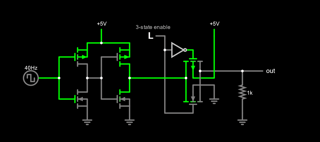A "normal" logic device will, except for brief moments while it is switching, connect every one of its outputs to either the positive or negative supply rail, based upon the states of its inputs. Note that the output of a device will not be connected to any of the inputs, but merely to a supply rail, with the choice of the supply rail determined by the inputs to the device.
Further, most assemblages of such devices are designed in such a way that every input will be connected to exactly one supply rail, through exactly one device, except for brief moments when it is switching. If two or more devices' outputs were connected together, then in situations where the devices connected them to the same rail, at least one of the devices would be redundant, and in cases where they tried to drive to different rails the devices would together tie the rails to each other, effectively forming a short circuit.
A "tri-state" or "three-state" output is designed so that in addition to being able to connect an output to the positive rail, or connect it to the negative rail, it may also decline to do either. It's possible, and often useful, to connect multiple three-state outputs together, provided that at any given time at most one of the outputs will be "active" (i.e. tied via the device containing it to one of the supply rails), and some devices will attach both output and input circuitry to the same individual pins, but the device will only be able to usefully send data to other devices when its output is active, and only usefully receive data from other devices when its output is inactive.
A transmission gate acts like a switch which, rather than connecting part of the circuit to a supply rail, instead connects two parts of the circuit to each other. When the gate is active and one side is connected to a supply rail, the transmission gate will effectively tie the other side to that same supply rail. Unlike a tri-state driver or an "input/output pin" which is connected both to a three-state output and to an input, a transmission gate doesn't need to know or care which side of it will be supplying or receiving data, provide that at any given time at least one of the following is true:
- The gate is inactive.
- Neither side is connected to the positive rail.
- Neither side is connected to the negative rail.
A disadvantage of a transmission gate is that it doesn't provide the current amplification that ordinary gates can provide. Even if the output of a logic gate is connected to 100 different logic elements, the device which drives it only needs to supply enough current to switch one. By contrast, if transmission gates were used to tie one logic output to 100 logic inputs, that output would need to supply enough current to drive all 100 inputs.
As a final note about transmission gates, most devices are designed using a process called CMOS, in which about half of the transistors are "NFETs", that turn on when the input is high, but can only switch signals that are lower than the input, and about half are "PFETs", which do the opposite. An inverter will have one NFET which connects the output to the negative rail when the input is high, and one PFET which connects the output to the positive rail when the input is low. The two transistors are turned on at opposite times, so a single logic input can be used to switch both. A transmission gate needs to have an NFET to be able to connect either side effectively to the negative rail, and a PFET to connect either side effectively to the positive rail, but in operation they should both be switched on simultaneously. To accommodate that, a transmission gate will need to have an active-high input to switch the NFET and an active-low input to switch the PFET. While there may be occasions where a gate might be usable even if only switches one or the other, they're fairly rare. Normally, if one side of a transmission gate is driven high and the PFET is off but the NFET is on, the other side will be connected to the positive rail well enough to cause trouble if it's also connected to the negative rail, but not well enough to reliably serve any useful purpose. Likewise, if one side is driven low when only the PFET is on.








